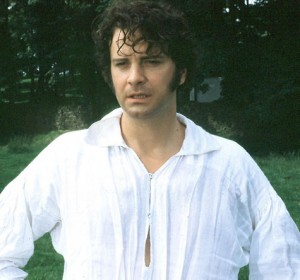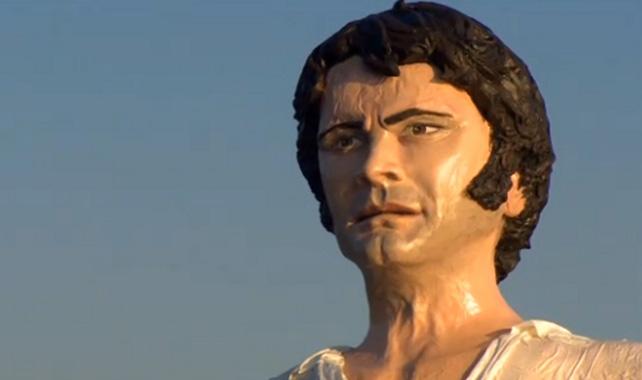Depicting Darcy: Austen’s hero resurfaces
A 12 ft high, fibreglass statue of Mr Darcy in a wet, white shirt has been created by a team at Taylor Herring and is currently located at the Serpentine lake in Hyde Park, London. The installation follows a UKTV survey which revealed that the infamous scene in which Colin Firth rises as Mr Darcy from the lake in his famed wet-shirt won most memorable moment in television drama. Despite the BBC adaptation being aired in 1995, eighteen years ago, Pride and Prejudice seems to have bewitched us ‘body and soul’.
 Colin Firth (aka. Mr Darcy, aka. Mr Mark Darcy) and the wet, white shirt come as a pair – they have become intertwined in our collective, cultural memory. For many, the definitive adaptation of Austen’s masterpiece is Andrew Davies’ BBC version of Pride and Prejudice. The first iconic scene of his production cemented Firth as the nation’s ‘Darcy’ – the most eligible young bachelor around. It is a role that Colin Firth has been unable to shake off, despite wining an Oscar for The King’s Speech. Since then, in a renowned allusion, Firth has resurfaced from a fountain rather than a lake in Bridget Jones’ Diary (tragically this time appearing in a somewhat less graceful, handsome manner and a little more clothed). A further parody was made in the form of Elliot Cowan, who took upon the role of Darcy in the television series Lost in Austen (2008), and who also emerged from a lake in a white shirt.
Colin Firth (aka. Mr Darcy, aka. Mr Mark Darcy) and the wet, white shirt come as a pair – they have become intertwined in our collective, cultural memory. For many, the definitive adaptation of Austen’s masterpiece is Andrew Davies’ BBC version of Pride and Prejudice. The first iconic scene of his production cemented Firth as the nation’s ‘Darcy’ – the most eligible young bachelor around. It is a role that Colin Firth has been unable to shake off, despite wining an Oscar for The King’s Speech. Since then, in a renowned allusion, Firth has resurfaced from a fountain rather than a lake in Bridget Jones’ Diary (tragically this time appearing in a somewhat less graceful, handsome manner and a little more clothed). A further parody was made in the form of Elliot Cowan, who took upon the role of Darcy in the television series Lost in Austen (2008), and who also emerged from a lake in a white shirt.
The statue has been designed to look like many of the actors who have played Mr Darcy over the years and is also inspired by the (admittedly spartan) descriptions of the hero in Austen’s novel. It has been temporarily placed at the Serpentine lake before it tours the UK and finally settles at Lyme Park, Cheshire, home of the original scene. There it will settle until February 2014. The creation of the statue is in essence a publicity stunt by UKTV to promote their new channel ‘Drama’, in lieu of their poll.
 I do always think, however, that Mr Darcy’s fame slightly relegates Elizabeth Bennett, and the many excellent portrayals of her in adaptations, to the back seat. In addition, Jane Austen’s wit and sharp cynicism in the novels is often lost on ogling ladies who are drawn-in by the character of Darcy and his wet shirt. Austen’s reputation for escapist romance is often perpetuated by these adaptations. So I urge all such ladies, and indeed men, to try reading Austen’s works themselves. And it should be noted that the lake scene does not exist in the novel, so as John Mullan points out, the statue “is an installation that celebrates the imagination of Andrew Davies rather than that of Jane Austen.”
I do always think, however, that Mr Darcy’s fame slightly relegates Elizabeth Bennett, and the many excellent portrayals of her in adaptations, to the back seat. In addition, Jane Austen’s wit and sharp cynicism in the novels is often lost on ogling ladies who are drawn-in by the character of Darcy and his wet shirt. Austen’s reputation for escapist romance is often perpetuated by these adaptations. So I urge all such ladies, and indeed men, to try reading Austen’s works themselves. And it should be noted that the lake scene does not exist in the novel, so as John Mullan points out, the statue “is an installation that celebrates the imagination of Andrew Davies rather than that of Jane Austen.”

Comments